As an entrepreneur, creating an email newsletter is an essential part of your overall marketing strategy that can help you generate future sales. A website visitor who finds your product expensive may be swayed by a discount sent to their inbox. A forgetful browser may be reminded of your product through a targeted email campaign. A potential buyer who needs more information can learn your company’s story through weekly mailings before finally clicking Buy. By capturing a prospect’s email, a purchase late today can be pushed back to tomorrow.
This guide will look at how to create a newsletter for your business that converts subscribers into buyers. While a newsletter can take many forms, we’ll specifically look at newsletters that send regular email updates about your business to subscribers, from behind the scenes of the company, and helpful content readers can use for product updates and price promotions. . We’ll go step-by-step, detailing why having a newsletter is important, tips for choosing the best email newsletter platform, a checklist for sending your first email, and tips on how to evaluate your analytics after you hit submit.
Learn how a newsletter helps you grow your business
64.1% of small businesses use email marketing. If you’re a business owner who wants to learn how to create a newsletter and jump-start your email marketing strategy, this guide will help you.
Cultivating a connection with potential and past buyers
According to Bluecore research, 74% of baby boomers and 64% of millennials consider email the most personal marketing channel. While marketing strategies like social media marketing, content, and paid marketing may seem broad, emails can be personalized for individual subscribers. Also, emails are sent directly to someone’s inbox, creating a direct connection. This is important when considering how people make purchasing decisions: many shoppers want to forge a personal connection with brands before they buy.
Sending emails to customers that provide value, whether it’s monetary value through discounts or informational value through compelling stories or information, builds a bridge of trust that can eventually lead to purchases. Carefully crafted newsletters can build affinity with your brand, which can be a powerful force in a business world rife with competition.
Build Buyer Consideration
If a customer lands on your digital storefront but decide not to buy, chances are they’ll never come back. However, if you catch their email before they leave your website, you can continue to communicate with them through newsletters sent to their inbox. Email newsletter marketing is a way to keep the conversation going after a potential customer has left your site, generating consideration for a future purchase.
Use a channel for discounts and updates
Discounts and promotional pricing can be powerful incentives for customers to buy your products. At Shopify, over Black Friday and Cyber Monday, 47 million shoppers spent $6.3 billion. While not every day can be a massive sales event, you can selectively use an email newsletter to send promotional codes or announce upcoming sales. For a potential customer who is feeling indecisive, an email promotion with a 10% discount code can push them to buy.
Adopting Your Own Channel
Organic social media reach has been declining for years and has been replaced by a pay-per-view model: the average reach of an organic post from social networks on Facebook is around 5%. Between ever-changing algorithms and crowded online spaces like the trending topics on Twitter and the busy newsfeed on Facebook, it’s hard to stand out on social media. While paid marketing such as Facebook Ads and Instagram Ads can work, they are becoming more expensive and reaching fewer customers as competition for keywords increases.
The Email is your own channel where you can talk directly with your customer. Once you have an email list of people who opted in to receive your updates, you own that list, regardless of whether you’re using an email platform like Mailchimp or ConvertKit. Email gives you a direct line of communication with potential customers that other channels don’t.
With all the ways newsletters can help you grow your business, it’s important to take the time to set specific goals for what content you’ll send to subscribers and what you want to accomplish with your email marketing. electronic.
Curious about growing a business through email marketing? Start your free trial on Shopify.
1. Define the purpose of your newsletter
There’s a lot you can do for your business with an ezine. Before you choose your email platform and dive into writing your first mailing, consider the goal of your newsletter.
- Building relationships and audience. One of the main benefits of an email newsletter is connecting with potential and past buyers, building a long-term audience. Achieve this by sharing helpful information with readers and/or providing behind-the-scenes details about your business with subscribers. For example, if you sell household items, you can send emails detailing interior design and decorating tips (eg, “5 Tips to Get Your Home Ready for the Holidays”). With your newsletter, go beyond simply promoting your products and provide content that positions you as an authority and builds credibility in your niche.
- Education. A newsletter is a great way to provide educational content, teaching subscribers the ways they can use your products. For example, if you sell makeup brushes and beauty tools, send tutorials on how to use them to create a complete New Year’s Eve look. If you’re selling a 2022 stationary planner, send out emails to educate subscribers on setting goals or completing an annual review using the product. Education can convince potential customers to buy and retain existing customers.
- Selling products and services. One of the main ways to use your email marketing newsletter e-mail is to directly sell your products and services. . Play the role of curator, featuring new products or best-selling items in your newsletter to drive traffic to your website. Occasionally provide limited-time discounts and promotional pricing to subscribers.
- Recommendations. An email newsletter can be an ambassador-building tool. Provide email subscribers with a referral link to help them spread the word about your business in exchange for a reward. For example, extend a 10% discount code to your friends and give them 10% off their next purchase for every successful referral. This can be especially effective for subscription businesses with recurring revenue.
- Customer feedback and research. Use your newsletter to solicit customer feedback and conduct user research. Instead of using a no-reply email (for example, [email protected]), use one where readers can reply directly to your communication. Alternatively, send out short surveys for your readers to answer.
You don’t have to choose just one goal for your newsletter. On the other hand, your newsletter does not need to achieve all the objectives on the list. Select, then prioritize a few goals and think about how you can use your newsletter content to achieve them. For example, you might have an educational newsletter that also gives readers a referral link at the bottom. On top of that, you can send a promotional email once every two months. Understand what type of newsletter content will serve the business goals you want to achieve and plan your email marketing strategy accordingly.
2. Figure Out Your Email Newsletter Strategy
Setting up an email newsletter strategy sounds serious and daunting, but it really just means figuring out some of the details about your newsletter before you start sending out emails. For example, think about who you hope to reach, the audience segments you’ll create content for, the topics you’ll cover, how people will sign up for updates, and how often you’ll email subscribers. These details will help you form an email marketing strategy that can evolve over time.
Define your audience
Your audience is who you’re trying to reach and communicate through your email. newsletter . If you are a business owner with the ultimate goal of having your email marketing support your business, this audience is likely to include potential buyers and/or past customers. But what are the defining characteristics of these groups? You probably have an ideal customer profile defined for your business that can also serve as the ideal audience for your newsletter; for example, tech-savvy millennial parents with young children residing in North America with a household income of $100,000 or more. By defining who you are trying to reach and convert through your newsletter, you can create better content for this audience.
Narrow down your audience segments
Audience segmentation means sending targeted emails to cohorts of your email list. This allows for a level of customization and personalization that best serves readers. In action, you might have an email list of 1000 subscribers and a customer segment of 750 subscribers receiving updates on glasses and sunglasses and 250 subscribers receiving updates on sunglasses only. Email segmentation helps prevent email fatigue or subscribers missing out on the information that is most important to them.
One way to segment subscribers is by asking them the topics that matter most to them when they register. their newsletter and sending them emails according to their interests.On a technical level, email newsletter platforms make it easy to segment your list and make this process automatic. However, the challenge of email segmentation is creating content for each segment, which can be time consuming as a business owner. Try to test segmentation as a long-term strategy as your newsletter list grows, but generally stick with one list to start with.
Decide your topics
Determine your content strategy and the specific topics you will cover in your newsletter. The type of content you write should be informed by the objective of your newsletter. If you sell custom-made dinnerware and utensils, you can choose topics like how-to information on hosting the perfect dinner party or educational tips on how to keep your silverware scratch-free.
Choose topics that are relevant to readers and that get them to open your emails instead of leaving them unread. You don’t have to think about all the topics you will cover at once. However, it helps to develop an email content calendar where you plan your content a few weeks in advance.
Determine email capture points
Consider where people will be able to enter their email address and sign up for your newsletter. For example, your website visitors can fill out a form and subscribe from your home page. If you have a blog, ask people to sign up via a popup on the page or in a form at the bottom. Include a link to sign up for your newsletter in the bio section of your social media platforms. If a customer makes a purchase and enters their details at checkout, ask them to sign up for your newsletter as well. Be intentional and think about how to build an email list through multiple capture points.
Decide on your sending cadence
Getting the cadence right for sending newsletters is part art and part science. You don’t want to overwhelm people with emails, so updates feel special when they arrive in someone’s inbox. But you don’t want to email so infrequently that it’s not top of mind when it comes time to buy or refer. Also, consistency is key: stick to sending on the same days of the week and avoid setting a cadence that you can’t keep up.
By taking time to establish an email marketing strategy, you can intentionally with the way you approach your newsletter and see results that have an impact on your business.
3. Choose your newsletter platform
Each email newsletter platform has its own unique features, benefits, and pricing. While you may not need all the features available to get started, it’s worth considering a platform with all the features you’ll need as you scale.
For example, when you’re just starting to send out a newsletter, you may not need advanced features like email segmentation and automation. However, your newsletter can evolve over time into a full email marketing strategy where these features can come in handy.
Here are some features to consider when selecting an email newsletter platform that fits today and fits tomorrow:
- Built-in templates and customizable themes. Customize the layout, colors, fonts, and images of your shipments with drag-and-drop functionality.
- Email personalization. Add a personal touch to emails with the ability to include subscriber details in the email content with combination tags (eg name).
- Email segmentation. Split your email subscribers into different lists to deliver more relevant content based on specific groupings.
- Email automation. Automatically send prewritten emails to subscribers after a particular action, at a specific time, or at a predetermined cadence (for example, a welcome email).
- Email Scheduling. Write emails ahead of time and schedule them for later.
- Email test. Send yourself test emails before sending out a newsletter to your entire list.
- A/B testing capabilities. Split up a mailing to see which one works best, sending one version of a newsletter to half your list and another version to the other half.
- Campaign measurement and analysis. See metrics like open rate, click-through rate, and unsubscribes for every newsletter you send out.
In addition to these features, also consider how simple and straightforward the interface is, the cost of sending emails and any subscriber limits. The following email newsletter platforms all have the aforementioned features, to varying degrees, and are worth considering when building your newsletter.
Shopify Email
Shopify Email is email marketing electronic made for commerce. If you’re a Shopify entrepreneur, you can use Shopify Email to easily design emails without having to write a line of code. You can create, send, and track campaigns, all from Shopify.Set up automations that keep your growing business in the background and create customer segments to provide a personal shopping experience. Shopify Email is free to install through the Shopify App Store.
Pricing: Shopify is free for up to 10,000 emails per month. Beyond this, you pay $1 for every 1,000 emails you send. There are no monthly plan fees.
Mailchimp
Mailchimp is an all-in-one marketing platform for small businesses. Use Mailchimp to create complete email marketing campaigns and more. Mailchimp integrates with Shopify, allowing you to sync Shopify customer, product, and purchase data with Mailchimp.

Pricing: Mailchimp has four plans: Free, Essential, Standard, and Premium. Learn more about plan pricing on the Mailchimp pricing page.
ConvertKit
ConvertKit is a marketing platform for creators, built for creators by creators. Their email marketing software allows you to create custom content using simple email templates and create customizable segments and automated email funnels. ConvertKit integrates with Shopify.
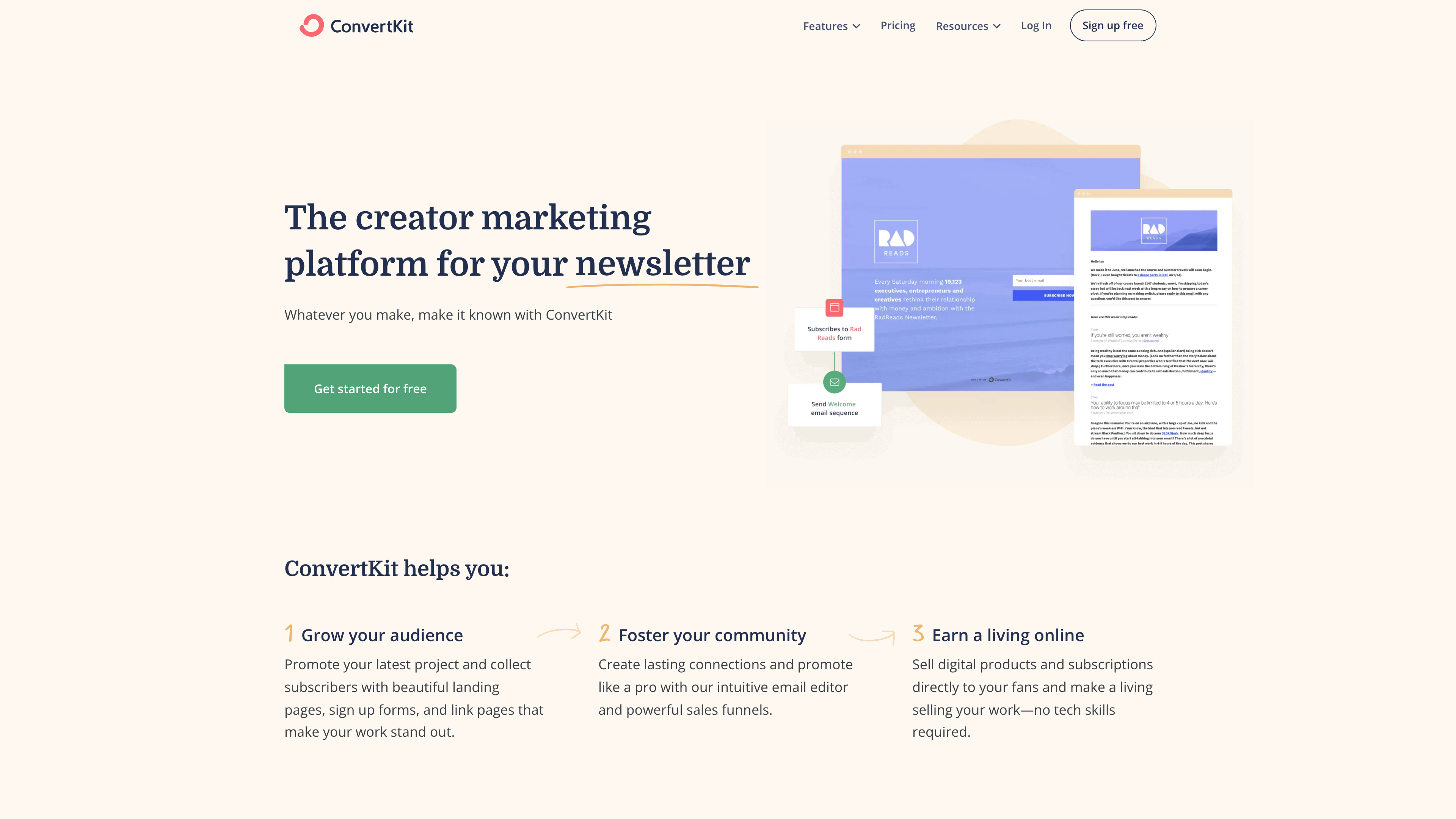
Price: ConvertKit has a Free, Creator, and Creator Pro plan. It also comes with monthly or yearly billing. Learn more about plan pricing on the ConvertKit pricing page.
Campaign Monitor
Campaign Monitor offers simple email marketing and automation tools to help businesses to connect with your audience. Its email marketing features include an easy-to-use drag-and-drop email builder, full customization, mobile optimization, and more. Campaign Monitor integrates with Shopify, allowing you to use customer data from your Shopify store to create timely email marketing campaigns.
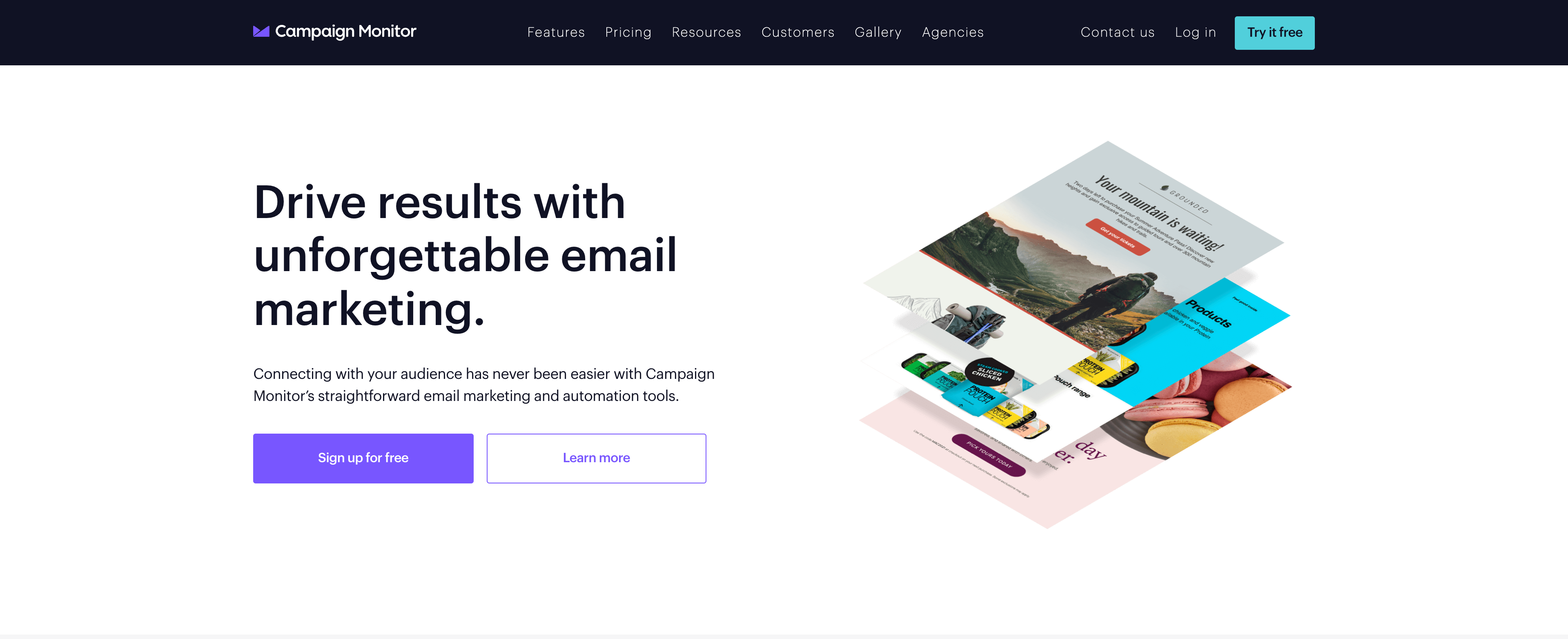
Price: Campaign Monitor has a Basic, Unlimited, and Premier plan. Learn more about plan pricing on the Campaign Monitor pricing page.
MailerLite
MailerLite provides email marketing tools along with additional support for websites, windows, and more. emerging and sale of digital products. The platform allows you to create dynamic emails and develop professional campaigns. MailerLite integrates with Shopify, allowing you to sync popups and email campaigns with customer information and Shopify purchase history.

Pricing: MailerLite has a free and premium plan. Learn more about plan pricing on the MailerLite pricing page.
Sendinblue
Sendinblue is an all-in-one marketing platform to help you grow your business with email, SMS, chat, and more. Their email marketing platform allows you to craft your message, personalize content, and send to subscribers based on segmentation. Sendinblue integrates with Shopify, allowing you to include Shopify products directly in email campaigns and more.
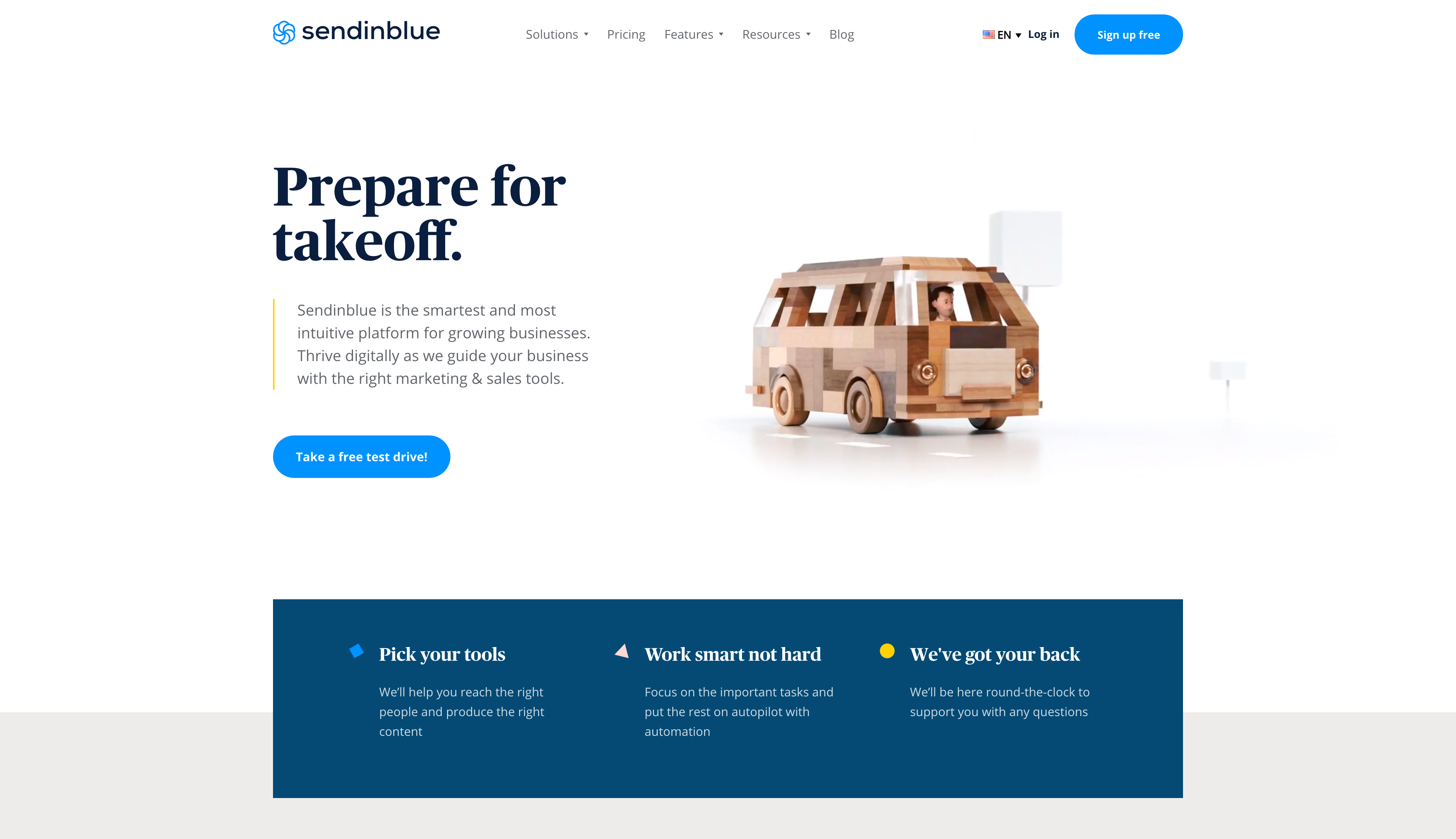
Pricing: Sendinblue has Free, Lite, Premium and Enterprise plans. Learn more about the pricing of the plans on their pricing page.
The beauty of building an audience through an email newsletter is that you can take your list with you wherever you go. If you outgrow one platform or just find one that works better for your business, you can switch without missing a beat.
4. Create a design template and customize your newsletter theme
In addition to the type of content you share in your newsletter and how you interact with your subscribers, one of the best ways to stand out in an inbox is to have a custom designed theme (a specific color scheme, layout, and font) that is recognizable to your audience. A consistent design theme helps build a sense of familiarity with the content you send to subscribers.
Fortunately, most newsletter platforms have a variety of templates and themes that you can create yourself, swapping out preset colors for a color scheme that matches your brand, and swapping out standard font selections for ones. that work with the rest of your marketing. As an example, Shopify’s email builder lets you select from dozens of pre-made templates for things like vacations and new product updates, which can be customized by adding sections or changing colors and layout. You can also select your products and customize how they are displayed.
Our Place is a company that makes products for cooking at home, including its famous and photogenic Always Pan that comes in unique colors ranging from spices to sage. Your email newsletter uses a modern, color-rich theme that is reminiscent of your website and instantly stands out in a sea of emails.
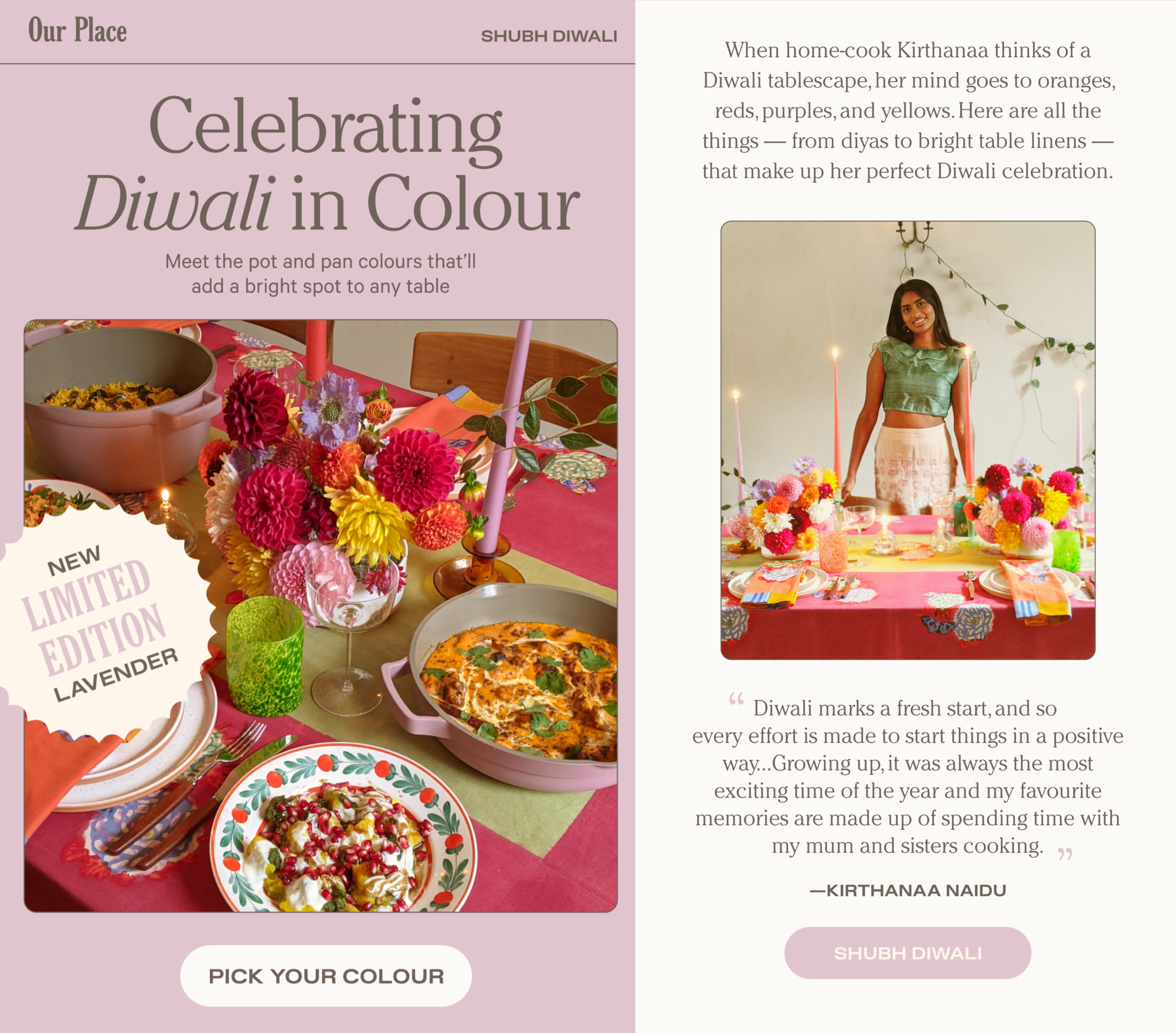
Be intentional in choosing a layout and design theme that resonates with your Current Branding – Various email marketing platforms let you upload your branding kit so you have your company colors and fonts handy in the email builder.An eye-catching design theme serves as a brand touchpoint familiar to subscribers.
5 Set Your Sending Schedule
There is a lot of information online about how often you should send your newsletter and precisely when you should send it , down to the day of the week and the time of day. The differences between open rates and click rates are small.
- MailerLite found that the email open rate was fairly constant, regardless of how often the emails were sent, decreased decreasing only slightly as the frequency increases. For example, emails sent monthly had a 40.33% open rate, emails sent weekly had a 39.6% open rate, while emails sent daily had a 37% open rate. . .67% open rate.
- Campaign Monitor benchmark data found that Fridays had the best open rates, at 18.9%, while Saturdays had the worst open day , with 17.3%. Fridays also had the best click-through rate at 2.7%, while Saturdays had the worst click-through rate at 2.4%. Email unsubscribe rates were the same for every day of the week, hovering around 0.1%.
Ultimately, this data demonstrates that there is no perfect cadence or time to send out email newsletters. While data like this can inform your newsletter delivery strategy, avoid letting these marginal differences really drive your strategy. Instead, consider the most realistic day(s) of the week to consistently send out your newsletter and stick to that. To get started, it can help to commit to sending weekly or bi-weekly newsletters on the day of the week that is most convenient.
A Copenhagen-based online business selling curated, high-quality posters, art prints and frames, The Poster Club sends out a weekly newsletter packed with design inspiration for your prints, plus updates on new products and artist collaborations.

Timing and cadence that you can commit to regularly will generally serve as the most effective strategy.
6. Ask people to sign up on your website and social media
Aim to capture newsletter subscribers where people already engage with your business, such as on your website and social media. Get subscribers by integrating signup forms into your marketing and sales channels.
Adding an email signup form on Shopify and other websites is usually simple and doesn’t require any specialized coding skills.
Embed your signup form into your website
One of the best places to add a signup form to your newsletter is on your website’s home page. You can create a popup that fires when someone lands on your page and/or a permanent form in your header, footer, or somewhere else on the page.
Craft compelling copy that lets subscribers know what to expect from your newsletter. Also, consider incentivizing people to sign up for your newsletter with the following strategies:
- Exclusive content, behind-the-scenes information, and upcoming discounts
- A discount for advance in exchange for your email
- Participation in a contest or sweepstakes in exchange for your email
Our site incentivizes subscriptions by entering new email subscribers in a daily contest to win your Always Bread, a $195 value.

BLK & Bold, a specialty coffee and tea company that donates 5% of its profits to social causes, offers a 15% discount to website visitors.

Providing a modest discount to incentivize a signup could lead to future sales if a subscriber opts in to receive your newsletter long term. These strategies can turn occasional visitors into long-term subscribers who are more likely to buy.
Embed Your Signup Form During Checkout
Once a website visitor has paid for and purchased an item, ask them to sign up for your email newsletter with the information you’ve provided. This can help you send customers educational information about product usage or help incentivize more purchases, referrals, and referrals in the future.
Share signup links on social media
Use your property on social media to get followers to sign up for your newsletter. For example, add a link to sign up for your newsletter in your company’s Instagram bio or include it in the About section of your company’s Facebook page.Alternatively, if you’re using a “link in bio” app like Linkpop, add your newsletter signup link to the list.
Don’t forget to promote your newsletter directly to your followers. Share occasional updates on your social channels (Twitter, Facebook, LinkedIn, Instagram) to remind followers that you have a newsletter and share the information they’ll receive upon signing up.
People won’t find out about your newsletter by accident; Be intentional when displaying signup forms and links to your newsletter to grow your list.
7. Customize Your Automated Email Flow
Most of the newsletters you send will likely be custom-written and sent weekly with interesting information, relevant updates, and new promotions. However, there are a handful of emails that can be automated, such as your welcome email or unsubscribe email. These serve as both first and last impressions and it’s important to get it right.
For a welcome email, thank new subscribers for signing up, set the stage for what readers can expect, and share any relevant links . Teddy Fresh, a Los Angeles-based streetwear company of YouTuber and artist Hila Klien, welcomes new subscribers to its list with a brand introduction email and links readers to the website .
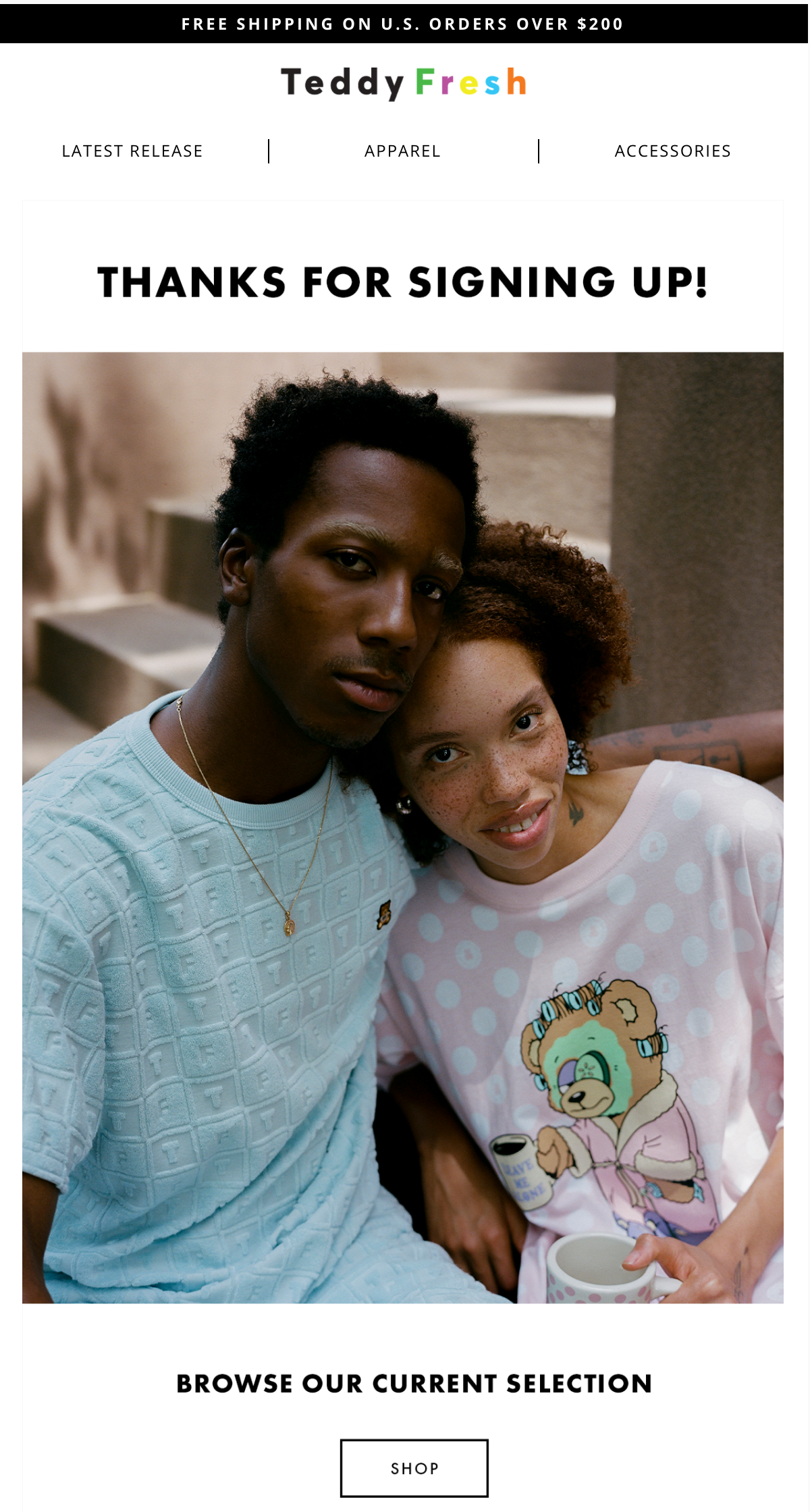
If you unsubscribe from your mailing list, your goodbye screen is customized with your logo and brand colors.

Make sure every touch point with readers feels authentic and connected to your brand. In addition to welcome emails, you can ask new subscribers for their birthday and send an automatic birthday discount to each subscriber. Apply the same principles of personalization and the personal touch to every automated email you send.
8. Comply with privacy regulations and email best practices
Email addresses are the digital equivalent of phone numbers and have their own laws and regulations to protect people’s privacy. It’s important to remember these privacy laws and anti-spam guidelines as you build your newsletter email list.
- Comply with the General Data Protection Regulation (GDPR). Implemented in 2018, this Union European (EU) privacy law is applicable to anyone who processes and/or stores data of individuals located in the EU. Many platforms, like Mailchimp, comply with these laws and help users comply with them as well.
- Comply with anti-spam laws. CAN-SPAM (US) and CASL (Canada) are examples of anti-spam laws intended to protect consumers from spam and threats electronics. Email marketing platforms, such as Mailchimp, require that all email sent through their platform be CAN-SPAM compliant.
- Subscribers must be subscribed. Sending email communications to people who have not subscribed does not comply with the GDPR and is considered spam. Even customers who provide their email for a purchase must explicitly opt out of receiving newsletters that are not related to their order.
- Don’t buy email lists. Increasing your newsletter audience by purchasing email addresses is not considered “opting in” and is not GDPR compliant.
- Emails must contain an unsubscribe link. Subscribers must be able to opt out of receiving your email communications.
- Include your company’s contact information. Attach your company’s contact information to the footer of each email to comply with certain antispam laws.
Violation of GDPR and other privacy and antispam laws can result in fees and penalties for your business. Additionally, spam reports may cause your emails to be marked as junk or your account disabled on certain email newsletter platforms.
9. Deliver Your First Newsletter
Starting to send your first email can be both exciting and intimidating. However, by breaking down your newsletter send out into a few simple steps, you’ll have a repeatable process that you can follow over and over again.
Set your sender name and email address
If your newsletter is for your business, you have a few options on how to fill out the “from” field:
- The name of the company. While less personal, this is a great option for newsletters or promotional newsletters that need to be instantly associated with your brand (for example, “From: Lite Journal”).
- From first name and company name.Whether your newsletter shares behind the scenes of your business or aims to forge a more personal connection between the business owner and the audience, a name can build a more personal connection. This format increases awareness of the individual behind the brand, while maintaining company association (for example, “From: Talia from Lite Journal”).
Also, consider what kind of email address your newsletter will come from. A normal email address (eg [email protected]) will allow your subscribers to reply directly to your newsletters.
Alternatively, a no-reply email address (for example, [email protected]), which is not configured to receive incoming mail, prevents this. However, non-reply email addresses can affect delivery rates and may not comply with antispam and privacy laws.
As an email marketing best practice, opt for an email address regular email, even if it’s not personalized or closely monitored (eg, [email protected]). This allows for two-way communication and can feel more authentic.
Select your recipients
Choose the email list of subscribers to whom you will send your newsletter. If you have a single list, they should be simple, just pick that one. However, if you’ve segmented your list into more specific cohorts, be sure to select the right list for your specific mailing.
Create your subject line and preheader text
On average, a person sends and receives 121 commercial emails each day. Also, the average email open rate is only 18%. The title and preheader text invite subscribers to notice and open your newsletter in the sea of emails they receive every day. While your newsletter may not be explicitly selling anything, think of the headline as a sales pitch to entice a subscriber to click through and open your email.
Keep your headlines and preheader text short, snappy, and reveal the value a subscriber will get from reading. Also, consider how much space you have. Most email newsletter platforms will provide a character limit, but test how your headline looks on a mobile device where words are cut off if a line is too long.
Elaborate your content
With the details worked out, start writing your newsletter. Each newsletter you send out may have a slightly different purpose. Do you hope to form a more personal bond with readers through behind-the-scenes business storytelling? Is the purpose of this submission to share useful information related to your product? To promote an upcoming sale? Start with a goal in mind.
Here are some tips for writing your newsletter:
- Start with a strong start. As with any other piece of writing, capture the your reader’s attention right away so they keep scrolling to the bottom of your email.
- Keep your sentences clear and concise. Use simple language and pay attention to the sentences that they are too long or complex.
- Drive traffic to your website with a call-to-action (CTA). Ask subscribers to read more or buy from your website with a CTA button within your newsletter.
- Use a skimmable format. Divide long pieces of text using headings and eyeballs -attractive graphics.
- Add personalization where possible. Use combination tags within your newsletter platform to address subscribers by name, and add your own personal touches with a memorable signature.
If possible, have someone edit and proofread your newsletter before you hit send to get the right message.
Test your email
Most email newsletter platforms allow you to send yourself a test email before sending it out to your larger email list. This is a useful feature for detecting persistent misspellings or detecting formatting issues. Be sure to check how the format appears on both desktop and mobile – mobile clients account for 41.6% of email opens.
Press Send
And! ready! After delivering your newsletter to subscribers, move on to evaluating the performance of your mailing.
10. Evaluate Your Analytics
After successfully sending your email, it’s time to review your analytics. Most email newsletter platforms measure the performance of your sends and provide important email marketing metrics such as open rate, click-through rate, unsubscribes, and more.
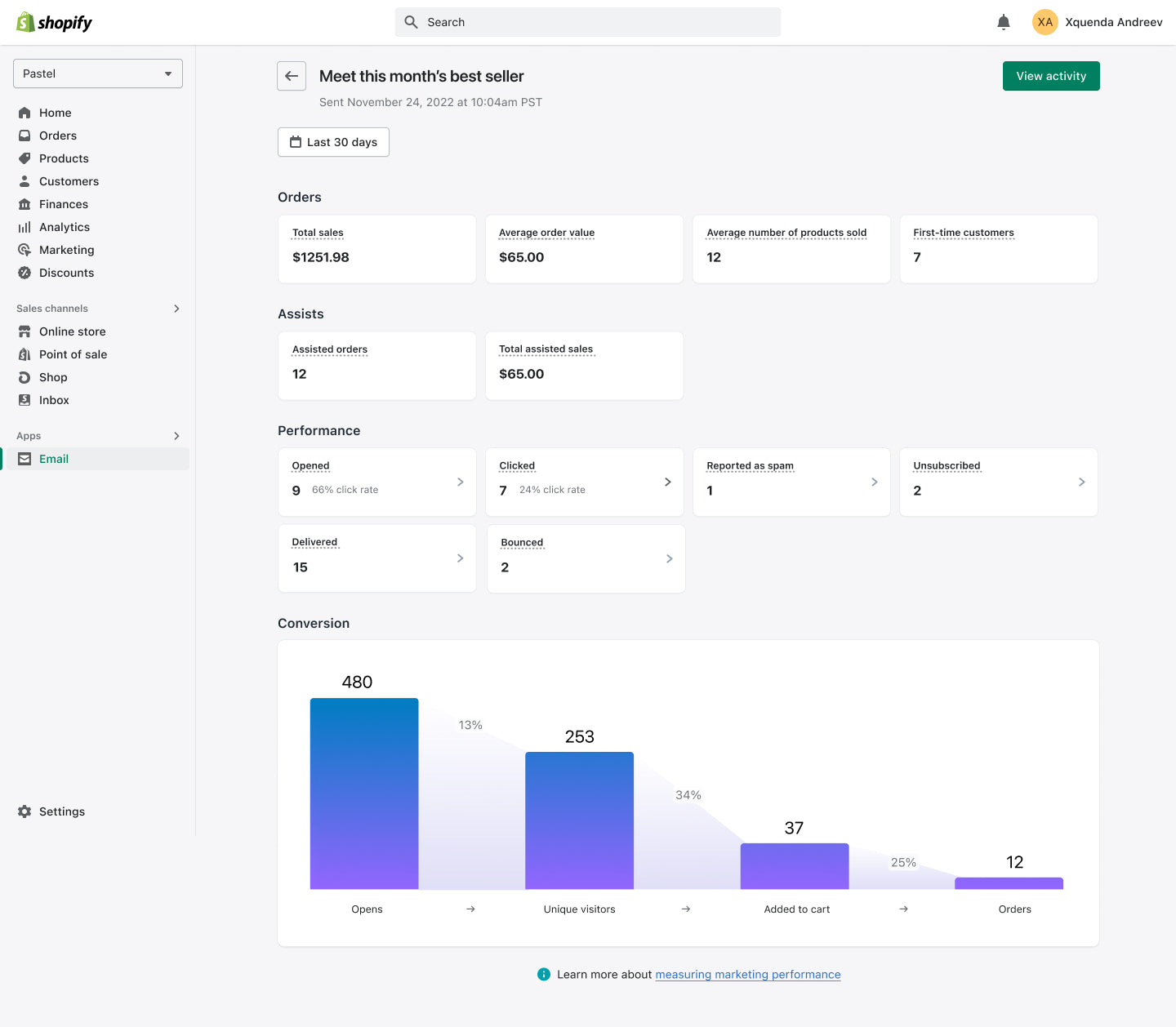
Here are some metrics worth tracking over time and paying attention to:
- Open rate. The percentage of subscribers who open your email newsletter.
- Click-through Rate (CTR). The percentage of subscribers who click a link in your email newsletter after to open it.
- Cancel subscription. The percentage of subscribers who opted out of receiving your email newsletter after opening it.
What constitutes a “good” open and click rate will largely depend on your industry; For example, the financial services industry has one of the highest email open rates. However, these 2020 email marketing benchmarks from Campaign Monitor are worth knowing:
- The average open rate is 18%. li>
- The average click through rate is 2.6%.
- The average unsubscribe rate is 0.1%.
You should also track how much traffic your newsletter drives to your website, as well as any conversions and sales you see through your email newsletter.
If you’re disappointed with the first results, keep experimenting! The beauty of a newsletter is that you can test different content and try different formats. You also have a direct line of communication with your subscribers, who can tell you what they want to read, just ask.
Start building your newsletter one subscriber at a time
From organic social media to paid advertising, there are plenty of ways to talk to potential customers and stay in touch with past buyers. But having an email newsletter allows you to send a message directly to a subscriber’s inbox, opening up a continuous channel of communication for sharing useful information, raising awareness about your products and services, and forging a connection that can lead to to purchase.
By collecting email from a website visitor or social media follower, you can start a conversation that turns a passive browser into a loyal customer.
.
